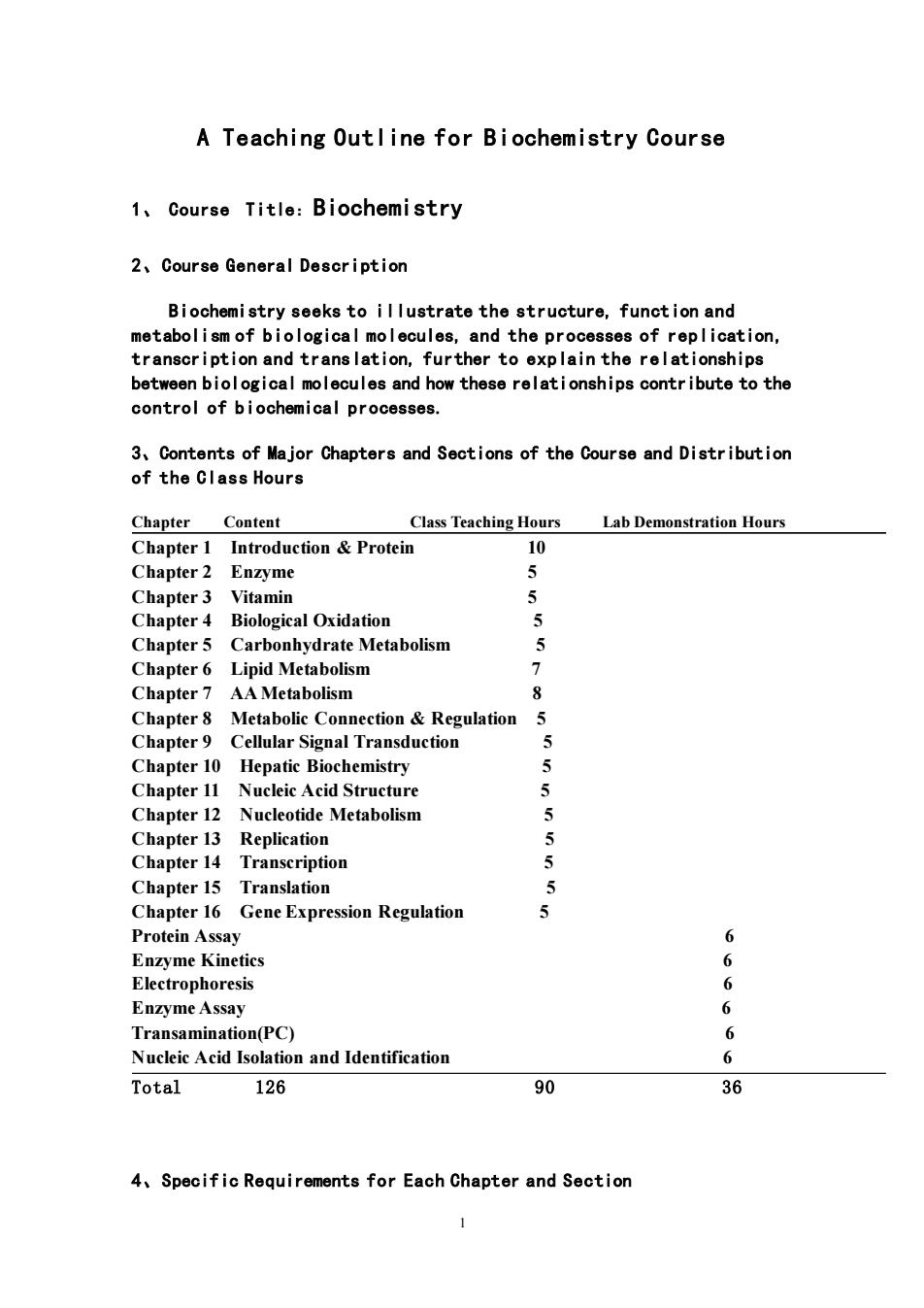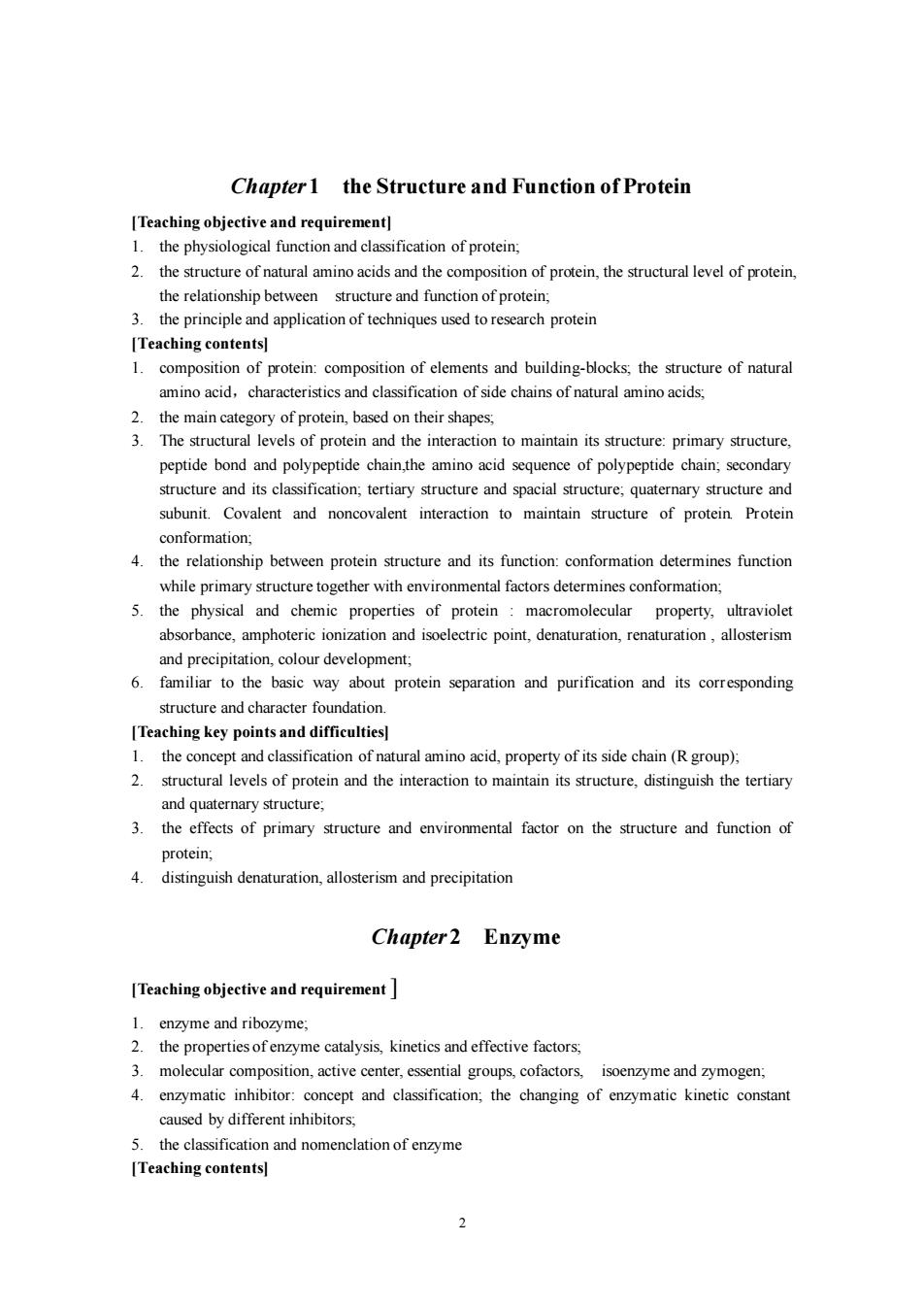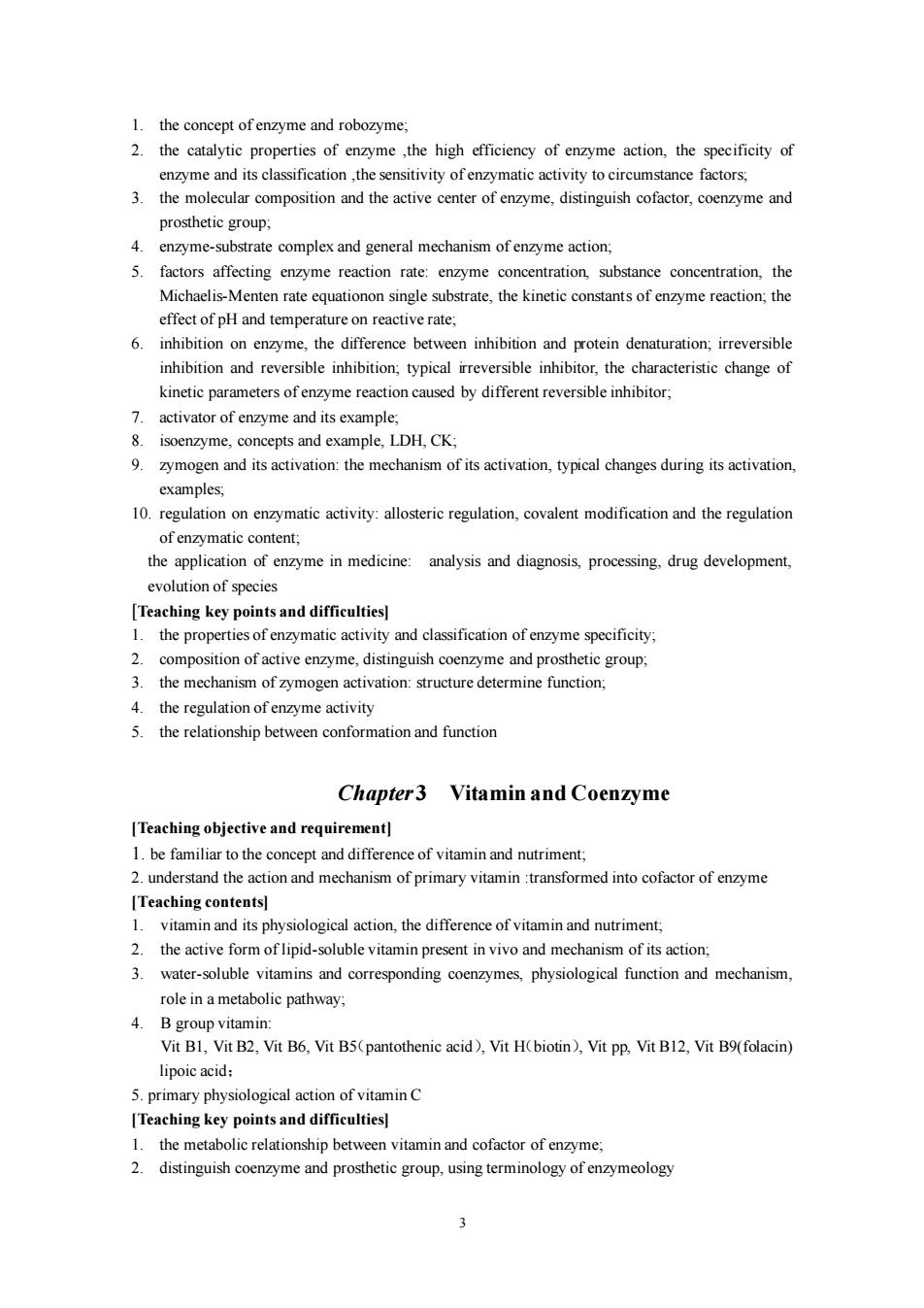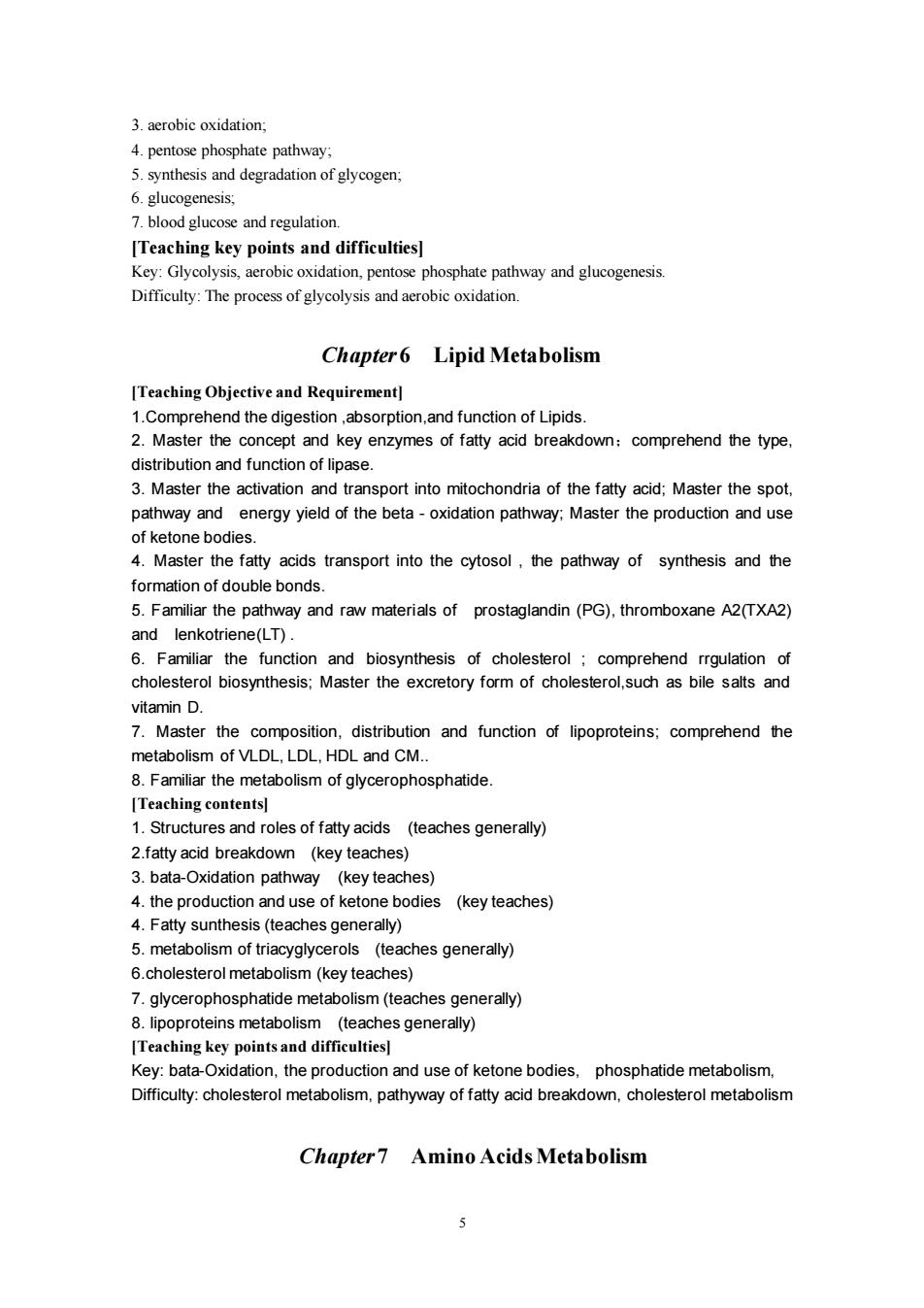
A Teaching Outline for Biochemistry Course 1.Course Title:Biochemistry 2,Course General Description Biochemistry seeks to il lustrate the structure,function and metabolism of biological molecules,and the processes of replication, transcription and trans lation,further to explain the relationships between biological molecules and how these relationships contribute to the control of biochemical processes. 3,Contents of Major Chapters and Sections of the Course and Distribution of the Class Hours Chapter Content Class Teaching Hours Lab Demonstration Hours Chapter 1 Introduction Protein 10 Chapter 2 Enzyme 5 Chapter 3 Vitamin 5 Chapter 4 Biological Oxidation 5 Chapter 5 Carbonhydrate Metabolism 5 Chapter 6 Lipid Metabolism > Chapter 7 AA Metabolism 6 Chapter 8 Metabolic Connection Regulation Chapter 9 Cellular Signal Transduction 心 Chapter 10 Hepatic Biochemistry 5 Chapter 11 Nucleic Acid Structure 5 Chapter 12 Nucleotide Metabolism 5 Chapter 13 Replication 5 Chapter 14 Transcription 5 Chapter 15 Translation 5 Chapter 16 Gene Expression Regulation 5 Protein Assay 6 Enzyme Kinetics 6 Electrophoresis 6 Enzyme Assay 6 Transamination(PC) 6 Nucleic Acid Isolation and Identification 6 Total 126 90 36 4,Specific Requirements for Each Chapter and Section
1 A Teaching Outline for Biochemistry Course 1、 Course Title:Biochemistry 2、Course General Description Biochemistry seeks to illustrate the structure, function and metabolism of biological molecules, and the processes of replication, transcription and translation, further to explain the relationships between biological molecules and how these relationships contribute to the control of biochemical processes. 3、Contents of Major Chapters and Sections of the Course and Distribution of the Class Hours Chapter Content Class Teaching Hours Lab Demonstration Hours Chapter 1 Introduction & Protein 10 Chapter 2 Enzyme 5 Chapter 3 Vitamin 5 Chapter 4 Biological Oxidation 5 Chapter 5 Carbonhydrate Metabolism 5 Chapter 6 Lipid Metabolism 7 Chapter 7 AA Metabolism 8 Chapter 8 Metabolic Connection & Regulation 5 Chapter 9 Cellular Signal Transduction 5 Chapter 10 Hepatic Biochemistry 5 Chapter 11 Nucleic Acid Structure 5 Chapter 12 Nucleotide Metabolism 5 Chapter 13 Replication 5 Chapter 14 Transcription 5 Chapter 15 Translation 5 Chapter 16 Gene Expression Regulation 5 Protein Assay 6 Enzyme Kinetics 6 Electrophoresis 6 Enzyme Assay 6 Transamination(PC) 6 Nucleic Acid Isolation and Identification 6 Total 126 90 36 4、Specific Requirements for Each Chapter and Section

Chapter 1 the Structure and Function of Protein [Teaching objective and requirement 1.the physiological function and classification of protein; 2.the structure of natural amino acids and the composition of protein,the structural level of protein, the relationship between structure and function of protein: 3.the principle and application of techniques used to research protein [Teaching contents] 1.composition of protein:composition of elements and building-blocks,the structure of natural amino acid,characteristics and classification of side chains of natural amino acids: 2.the main category of protein,based on their shapes, 3.The structural levels of protein and the interaction to maintain its structure:primary structure, peptide bond and polypeptide chain,the amino acid sequence of polypeptide chain;secondary structure and its classification;tertiary structure and spacial structure;quaternary structure and subunit.Covalent and noncovalent interaction to maintain structure of protein.Protein conformation: 4.the relationship between protein structure and its function:conformation determines function while primary structure together with environmental factors determines conformation; 5.the physical and chemic properties of protein macromolecular property,ultraviolet absorbance,amphoteric ionization and isoelectric point,denaturation,renaturation,allosterism and precipitation,colour development; 6.familiar to the basic way about protein separation and purification and its corresponding structure and character foundation. [Teaching key points and difficulties] 1.the concept and classification of natural amino acid,property of its side chain (R group); 2.structural levels of protein and the interaction to maintain its structure,distinguish the tertiary and quaternary structure; 3.the effects of primary structure and environmental factor on the structure and function of protein; 4.distinguish denaturation,allosterism and precipitation Chapter2 Enzyme [Teaching objective and requirement 1.enzyme and ribozyme; 2.the properties of enzyme catalysis,kinetics and effective factors; 3.molecular composition,active center,essential groups,cofactors,isoenzyme and zymogen; 4.enzymatic inhibitor:concept and classification;the changing of enzymatic kinetic constant caused by different inhibitors; 5.the classification and nomenclation of enzyme [Teaching contents]
2 Chapter 1 the Structure and Function of Protein [Teaching objective and requirement] 1. the physiological function and classification of protein; 2. the structure of natural amino acids and the composition of protein, the structural level of protein, the relationship between structure and function of protein; 3. the principle and application of techniques used to research protein [Teaching contents] 1. composition of protein: composition of elements and building-blocks; the structure of natural amino acid,characteristics and classification of side chains of natural amino acids; 2. the main category of protein, based on their shapes; 3. The structural levels of protein and the interaction to maintain its structure: primary structure, peptide bond and polypeptide chain,the amino acid sequence of polypeptide chain; secondary structure and its classification; tertiary structure and spacial structure; quaternary structure and subunit. Covalent and noncovalent interaction to maintain structure of protein. Protein conformation; 4. the relationship between protein structure and its function: conformation determines function while primary structure together with environmental factors determines conformation; 5. the physical and chemic properties of protein : macromolecular property, ultraviolet absorbance, amphoteric ionization and isoelectric point, denaturation, renaturation , allosterism and precipitation, colour development; 6. familiar to the basic way about protein separation and purification and its corresponding structure and character foundation. [Teaching key points and difficulties] 1. the concept and classification of natural amino acid, property of its side chain (R group); 2. structural levels of protein and the interaction to maintain its structure, distinguish the tertiary and quaternary structure; 3. the effects of primary structure and environmental factor on the structure and function of protein; 4. distinguish denaturation, allosterism and precipitation Chapter 2 Enzyme [Teaching objective and requirement ] 1. enzyme and ribozyme; 2. the properties of enzyme catalysis, kinetics and effective factors; 3. molecular composition, active center, essential groups, cofactors, isoenzyme and zymogen; 4. enzymatic inhibitor: concept and classification; the changing of enzymatic kinetic constant caused by different inhibitors; 5. the classification and nomenclation of enzyme [Teaching contents]

1.the concept of enzyme and robozyme; 2.the catalytic properties of enzyme,the high efficiency of enzyme action,the specificity of enzyme and its classification,the sensitivity of enzymatic activity to circumstance factors: 3.the molecular composition and the active center of enzyme,distinguish cofactor,coenzyme and prosthetic group; 4.enzyme-substrate complex and general mechanism of enzyme action; 5.factors affecting enzyme reaction rate:enzyme concentration,substance concentration,the Michaelis-Menten rate equationon single substrate,the kinetic constants of enzyme reaction;the effect of pH and temperature on reactive rate; 6.inhibition on enzyme,the difference between inhibition and protein denaturation;irreversible inhibition and reversible inhibition;typical irreversible inhibitor,the characteristic change of kinetic parameters of enzyme reaction caused by different reversible inhibitor: 7.activator of enzyme and its example; 8.isoenzyme,concepts and example,LDH,CK: 9.zymogen and its activation:the mechanism of its activation,typical changes during its activation, examples; 10.regulation on enzymatic activity:allosteric regulation,covalent modification and the regulation ofen☑ymatic content, the application of enzyme in medicine:analysis and diagnosis,processing,drug development, evolution of species [Teaching key points and difficulties] 1.the properties of enzymatic activity and classification of enzyme specificity; 2.composition of active enzyme,distinguish coenzyme and prosthetic group; 3.the mechanism of zymogen activation:structure determine function; 4.the regulation of enzyme activity 5.the relationship between conformation and function Chapter3 Vitamin and Coenzyme [Teaching objective and requirement] 1.be familiar to the concept and difference of vitamin and nutriment; 2.understand the action and mechanism of primary vitamin:transformed into cofactor of enzyme [Teaching contents] 1.vitamin and its physiological action,the difference of vitamin and nutriment; 2.the active form of lipid-soluble vitamin present in vivo and mechanism of its action; 3.water-soluble vitamins and corresponding coenzymes,physiological function and mechanism, role in a metabolic pathway; 4.B group vitamin: Vit B1,Vit B2,Vit B6,Vit B5(pantothenic acid )Vit H(biotin),Vit pp,Vit B12,Vit B9(folacin) lipoic acid: 5.primary physiological action of vitamin C [Teaching key points and difficulties] 1.the metabolic relationship between vitamin and cofactor of enzyme; 2.distinguish coenzyme and prosthetic group,using terminology of enzymeology
3 1. the concept of enzyme and robozyme; 2. the catalytic properties of enzyme ,the high efficiency of enzyme action, the specificity of enzyme and its classification ,the sensitivity of enzymatic activity to circumstance factors; 3. the molecular composition and the active center of enzyme, distinguish cofactor, coenzyme and prosthetic group; 4. enzyme-substrate complex and general mechanism of enzyme action; 5. factors affecting enzyme reaction rate: enzyme concentration, substance concentration, the Michaelis-Menten rate equationon single substrate, the kinetic constants of enzyme reaction; the effect of pH and temperature on reactive rate; 6. inhibition on enzyme, the difference between inhibition and protein denaturation; irreversible inhibition and reversible inhibition; typical irreversible inhibitor, the characteristic change of kinetic parameters of enzyme reaction caused by different reversible inhibitor; 7. activator of enzyme and its example; 8. isoenzyme, concepts and example, LDH, CK; 9. zymogen and its activation: the mechanism of its activation, typical changes during its activation, examples; 10. regulation on enzymatic activity: allosteric regulation, covalent modification and the regulation of enzymatic content; the application of enzyme in medicine: analysis and diagnosis, processing, drug development, evolution of species [Teaching key points and difficulties] 1. the properties of enzymatic activity and classification of enzyme specificity; 2. composition of active enzyme, distinguish coenzyme and prosthetic group; 3. the mechanism of zymogen activation: structure determine function; 4. the regulation of enzyme activity 5. the relationship between conformation and function Chapter 3 Vitamin and Coenzyme [Teaching objective and requirement] 1. be familiar to the concept and difference of vitamin and nutriment; 2. understand the action and mechanism of primary vitamin :transformed into cofactor of enzyme [Teaching contents] 1. vitamin and its physiological action, the difference of vitamin and nutriment; 2. the active form of lipid-soluble vitamin present in vivo and mechanism of its action; 3. water-soluble vitamins and corresponding coenzymes, physiological function and mechanism, role in a metabolic pathway; 4. B group vitamin: Vit B1, Vit B2, Vit B6, Vit B5(pantothenic acid), Vit H(biotin), Vit pp, Vit B12, Vit B9(folacin) lipoic acid; 5. primary physiological action of vitamin C [Teaching key points and difficulties] 1. the metabolic relationship between vitamin and cofactor of enzyme; 2. distinguish coenzyme and prosthetic group, using terminology of enzymeology

Chapter4 Biological Oxidation [Teaching Objective and Requirement] 1.Master the concept of biological oxidation and Mitochondrion oxidation system,be familiar with other oxidized systems. 2.Master the composition and arrangement of respiratory chian,the concept of Oxidative phosphorylation and P/O ratio;be familiar with the influence factors of oxidative phosphorylation,the concept of high-energy compound. 3.Master the biological function of glycerophosphate shuttle and malate-asparate shuttle. 4.Familiar the function of monooxygenase,dioxygenase,peroxisome,catalase,perosidase, and superoxide dismutase;comprehend the differences between dehydrogenase the aerobic dehydrogenase and the oxydase [Teaching contents 1.Mitochondrion oxidation system:complex of respiratory chian;the composition, arrangement and function of two respiratory chians;oxidiative phosphorylation and substrate level phosphorylation ATP and energy metabolism. 2.Other oxidized systems:monooxygenase,peroxisome,superoxide dismutase(SOD). [Teaching key points and difficulties] Key Mitochondrion oxidation system Difficulties:Oxidation and phosphorylation Chapter 5 Carbohydrate Metabolism [Teaching objective and requirement 1.Master the concept,process,key enzyme and physiological role of glycolysis and aerobic oxidation. 2.Master the concept of krebs cycle and Comprehend the regulation of krebs cycle. 3.Master the concept and physiological role of pentose phosphate pathway.Familiar the process of NADPH and 5-phosphoribose production. 4.Master the synthesis of glycogen,degradation of glycogen and its regulation (glycogen phosphorylase and glycogen synthase are the targets for regulation,mainly by chemical modification).Master the cause of glycogen in muscle cannot reduce to glucose. 5.Master the concept of glucogenesis,three irreversibly metabolic pathways,Lactate cycle and its physiological role.Comprehend the major process of glucogenesis with materials such as pyruvate, lactate,glycerol and some special amino acids.Comprehend the physiological role of glucogenesis. 6.Master the concept of blood glucose,source and fate of blood glucose.Comprehend the blood glucose regulation include hormone and organ regulation.Familiar the concept of glucose tolerance. [Teaching contents] 1.The major function of carbohydrate,the digestion and absorption of carbohydrate 2.glycolysis;
4 Chapter 4 Biological Oxidation [Teaching Objective and Requirement] 1. Master the concept of biological oxidation and Mitochondrion oxidation system, be familiar with other oxidized systems. 2.Master the composition and arrangement of respiratory chian, the concept of Oxidative phosphorylation and P/O ratio; be familiar with the influence factors of oxidative phosphorylation, the concept of high-energy compound. 3. Master the biological function of glycerophosphate shuttle and malate-asparate shuttle. 4.Familiar the function of monooxygenase, dioxygenase , peroxisome, catalase, perosidase, and superoxide dismutase; comprehend the differences between dehydrogenase ,the aerobic dehydrogenase and the oxydase. [Teaching contents] 1.Mitochondrion oxidation system: complex of respiratory chian; the composition , arrangement and function of two respiratory chians; oxidiative phosphorylation and substrate level phosphorylation ; ATP and energy metabolism. 2.Other oxidized systems: monooxygenase, peroxisome, superoxide dismutase(SOD). [Teaching key points and difficulties] Key : Mitochondrion oxidation system Difficulties : Oxidation and phosphorylation Chapter 5 CarbohydrateMetabolism [Teaching objective and requirement] 1. Master the concept, process, key enzyme and physiological role of glycolysis and aerobic oxidation. 2. Master the concept of krebs cycle and Comprehend the regulation of krebs cycle. 3. Master the concept and physiological role of pentose phosphate pathway. Familiar the process of NADPH and 5-phosphoribose production. 4. Master the synthesis of glycogen, degradation of glycogen and its regulation (glycogen phosphorylase and glycogen synthase are the targets for regulation, mainly by chemical modification). Master the cause of glycogen in muscle cannot reduce to glucose. 5. Master the concept of glucogenesis, three irreversibly metabolic pathways, Lactate cycle and its physiological role. Comprehend the major process of glucogenesis with materials such as pyruvate, lactate, glycerol and some special amino acids. Comprehend the physiological role of glucogenesis. 6. Master the concept of blood glucose, source and fate of blood glucose. Comprehend the blood glucose regulation include hormone and organ regulation. Familiar the concept of glucose tolerance. [Teaching contents] 1. The major function of carbohydrate, the digestion and absorption of carbohydrate 2. glycolysis;

3.aerobic oxidation, 4.pentose phosphate pathway; 5.synthesis and degradation of glycogen; 6.glucogenesis: 7.blood glucose and regulation. [Teaching key points and difficulties] Key:Glycolysis,aerobic oxidation,pentose phosphate pathway and glucogenesis. Difficulty:The process of glycolysis and aerobic oxidation. Chapter 6 Lipid Metabolism [Teaching Objective and Requirement] 1.Comprehend the digestion,absorption,and function of Lipids 2.Master the concept and key enzymes of fatty acid breakdown:comprehend the type, distribution and function of lipase. 3.Master the activation and transport into mitochondria of the fatty acid;Master the spot, pathway and energy yield of the beta-oxidation pathway;Master the production and use of ketone bodies. 4.Master the fatty acids transport into the cytosol,the pathway of synthesis and the formation of double bonds. 5.Familiar the pathway and raw materials of prostaglandin(PG),thromboxane A2(TXA2) and lenkotriene(LT). 6.Familiar the function and biosynthesis of cholesterol comprehend rrgulation of cholesterol biosynthesis;Master the excretory form of cholesterol,such as bile salts and vitamin D. 7.Master the composition,distribution and function of lipoproteins;comprehend the metabolism of VLDL,LDL,HDL and CM. 8.Familiar the metabolism of glycerophosphatide. [Teaching contents] 1.Structures and roles of fatty acids (teaches generally) 2.fatty acid breakdown (key teaches) 3.bata-Oxidation pathway (key teaches) 4.the production and use of ketone bodies (key teaches) 4.Fatty sunthesis(teaches generally) 5.metabolism of triacyglycerols (teaches generally) 6.cholesterol metabolism (key teaches) 7.glycerophosphatide metabolism(teaches generally) 8.lipoproteins metabolism (teaches generally) [Teaching key points and difficulties Key:bata-Oxidation,the production and use of ketone bodies,phosphatide metabolism, Difficulty:cholesterol metabolism,pathyway of fatty acid breakdown,cholesterol metabolism Chapter 7 Amino Acids Metabolism
5 3. aerobic oxidation; 4. pentose phosphate pathway; 5. synthesis and degradation of glycogen; 6. glucogenesis; 7. blood glucose and regulation. [Teaching key points and difficulties] Key: Glycolysis, aerobic oxidation, pentose phosphate pathway and glucogenesis. Difficulty: The process of glycolysis and aerobic oxidation. Chapter 6 Lipid Metabolism [Teaching Objective and Requirement] 1.Comprehend the digestion ,absorption,and function of Lipids. 2. Master the concept and key enzymes of fatty acid breakdown;comprehend the type, distribution and function of lipase. 3. Master the activation and transport into mitochondria of the fatty acid; Master the spot, pathway and energy yield of the beta - oxidation pathway; Master the production and use of ketone bodies. 4. Master the fatty acids transport into the cytosol , the pathway of synthesis and the formation of double bonds. 5. Familiar the pathway and raw materials of prostaglandin (PG), thromboxane A2(TXA2) and lenkotriene(LT) . 6. Familiar the function and biosynthesis of cholesterol ; comprehend rrgulation of cholesterol biosynthesis; Master the excretory form of cholesterol,such as bile salts and vitamin D. 7. Master the composition, distribution and function of lipoproteins; comprehend the metabolism of VLDL, LDL, HDL and CM. 8. Familiar the metabolism of glycerophosphatide. [Teaching contents] 1. Structures and roles of fatty acids (teaches generally) 2.fatty acid breakdown (key teaches) 3. bata-Oxidation pathway (key teaches) 4. the production and use of ketone bodies (key teaches) 4. Fatty sunthesis (teaches generally) 5. metabolism of triacyglycerols (teaches generally) 6.cholesterol metabolism (key teaches) 7. glycerophosphatide metabolism (teaches generally) 8. lipoproteins metabolism (teaches generally) [Teaching key points and difficulties] Key: bata-Oxidation, the production and use of ketone bodies, phosphatide metabolism, Difficulty: cholesterol metabolism, pathyway of fatty acid breakdown, cholesterol metabolism Chapter 7 Amino AcidsMetabolism